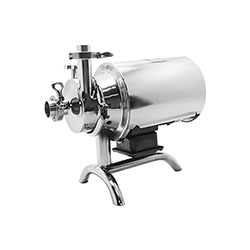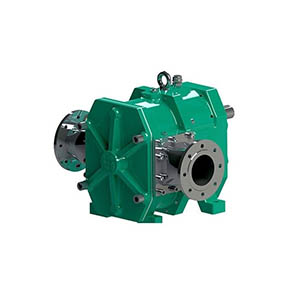Rotary Pumps vs. Centrifugal Pumps: What are Their Differences?
Rotary pumps and centrifugal pumps are widely used in our daily life, so do you know what differences are they between rotary pumps and centrifugal pumps? ATO has prepared a detailed definition and introduction of their main variances.
Centrifugal Pump Basics
A centrifugal pump is a pump that relies on the centrifugal force generated by the rotation of an impeller to transport liquid. Centrifugal pumps work by using the centrifugal motion of water caused by the rotation of the impeller. Before the  pump starts, the pump casing and suction pipe must be filled with water, and then the motor starts to work, which makes the pump shaft drives the impeller and water to do high-speed rotational movement, and then the water undergoes centrifugal movement and is thrown to the outer edge of the impeller flowing into the pressure pipe of the pump through the flow channel of the worm-shaped pump casing. The basic structure of centrifugal pump includes: impeller, pump body, pump cover, water retaining ring, pump shaft, bearing, sealing ring, stuffing box, axial force balancing device, different devices represent different functions.
pump starts, the pump casing and suction pipe must be filled with water, and then the motor starts to work, which makes the pump shaft drives the impeller and water to do high-speed rotational movement, and then the water undergoes centrifugal movement and is thrown to the outer edge of the impeller flowing into the pressure pipe of the pump through the flow channel of the worm-shaped pump casing. The basic structure of centrifugal pump includes: impeller, pump body, pump cover, water retaining ring, pump shaft, bearing, sealing ring, stuffing box, axial force balancing device, different devices represent different functions.
- Impeller is the core, responsible for the rotation speed and output strength.
- The pump body is the main body of the water pump. It makes the role of supporting and fixing, connected with the bracket for mounting bearings
- The role of pump shaft is to connect with motor by coupling, transmitting the torque of motor to impeller, so it is the main part to transmit mechanical energy.
- The sealing ring is the leakage reducing ring.
- The stuffing box mainly consists of packing to stop the water flowing out of the pump and prevent air outside from coming into the pump inner to keep the vacuum inside the pump. When the pump shaft and packing friction generate heat ,it needs to rely on the water seal tube injection to the water seal ring to make the packing cool.
- Axial force balancing device, in the operation of the centrifugal pump, the liquid is into the impeller at low pressure, and out at high pressure, so that the pressure on both sides of the impeller is not equal. It results in the axial thrust in the direction of the entrance, which will cause the rotor to axial movement, friction and vibration, so the axial thrust bearing should be set to balance the axial force.
Rotary Pump Basics
Rotary pump is a kind of rotating displacement pump with positive displacement nature, which means a pump that changes the working volume through the relative motion between the rotor and the pump body, thus increasing the  energy of the liquid. It consists of a rotating rotor and a stationary pump body, which has no suction and discharge valves, and changes the working volume by the relative motion between the rotor and the pump body, and discharges the liquid by the squeezing effect of the rotor of rotation, while leaving space on the other side to form a low pressure, so that the liquid is continuously drawn in.
energy of the liquid. It consists of a rotating rotor and a stationary pump body, which has no suction and discharge valves, and changes the working volume by the relative motion between the rotor and the pump body, and discharges the liquid by the squeezing effect of the rotor of rotation, while leaving space on the other side to form a low pressure, so that the liquid is continuously drawn in.
The structure of rotary pumps can be divided into gear pumps, screw pumps,vane pumps, rotary piston pumps (lobe pumps, Roots pumps), flexible impeller pump, sliding vane pump, hose pump, etc. The rotary pump is a rotary volumetric pump, with positive displacement nature, its flow does not change with the change of air pressure.
In industrial manufacture, centrifugal pumps account for about 80% of the total number of pumps, and rotor pumps account for about 10%. Because rotary pumps and centrifugal pumps essentially operate on different principles, the applicable occasions they suit are also different, the following is the introduction of the characteristics of rotary pumps and centrifugal pumps.
Centrifugal Pump Application
Centrifugal pump is suitable for liquid transportation, relying on the impeller centrifugal force to form a vacuum suction to lift the liquid. When the centrifugal pump starts, the gate valve must be closed firstly, and then irrigate. The water level exceeds above the impeller part and the air in the centrifugal pump is discharged before it can be started. After starting, a vacuum is formed around the impeller to suck the water upward, and its gate valve can be opened automatically to lift the water. The followings are the places to consider when choosing a centrifugal pump
- Compact structure
- Wide range of flow and head
- Suitable for mildly corrosive liquids
- Various control options
- Uniform flow, smooth operation and low vibration. No need for special vibration-damping foundation.
- Low cost of equipment installation, maintenance and repair.
Rotary Pump Application
In general, for a variety of viscosity of the liquid transport, rotary pumps have advantages other pumps incomparable, but in the liquid transport, not only the viscosity of the problem, and often accompanied by high temperature, high pressure and sometimes corrosive, or contain solid particles. For this reason, when selecting a rotary pump, the following requirements must be considered.
- The flow of the liquid to be transported, the choice of pump for the viscosity of the applicable range.
- Suction function, pumping performance at high viscosity.
- High temperature resistance, corrosion resistance, etc.
- Simple structure, easy to disassemble, cleaning and maintenance, etc.
Differences between Rotary Pumps and Centrifugal Pumps
1. Different Mediums Conveyed
Rotary pump: it can convey vapor-liquid-solid three-phase mixture materials, as well as highly viscous items. A rotary pump is suitable for: viscous liquids, occasions need to measure, self-priming, containing gas or small flow occasions. A rotary pump main components of the structure are the pump casing and rotor, such as gears, screws, cams, etc. And there is no suction valve and discharge valve. And the rotor for the rotary motion, no impact, and high speed, compact structure, small size. Most rotary pumps are lubricated by the liquid they convey, so they are generally suitable for conveying liquids that are lubricated and do not contain solid particles. The rotary pump belongs to intermittent discharge liquid, so the fluctuation of flow is larger than that of centrifugal pump. When a liquid film exists on the surface of the rotor (conveying lubricious liquid), the pump will have self-priming capability.
Centrifugal pump: It is suitable for mildly corrosive liquids and cannot convey media with high viscosity. Centrifugal pump can be widely used in electric power, metallurgy, coal, building materials and other industries to convey slurry containing solid particles. Such as thermal power plant hydraulic ash removal, metallurgical beneficiation plant ore slurry conveying, coal washing plant coal slurry and heavy medium conveying, etc.
2. Different Flow Control
Rotary pump: The rotor pump is a volumetric pump, the conveying flow can be controlled more precisely, and it can also be easily made into a variable pump. A rotary pump has a strong self-priming ability, and it can accurately control the flow rate of delivery, its speed and delivery flow rate is proportional. Its flow rate will not change with the change of back pressure. For occasions with metering requirements, the selected pump has good performance stability when viscosity and other process conditions change. The back pressure of the system.
Centrifugal pump: the output flow rate of centrifugal pump is not controllable and decreases with the increase of its own resistance. It is difficult to control the flow rate delivered, and the higher its outlet pressure, the lower the degree of flow control. Compact structure. It is more suitable for average flow, smooth running liquid transportation
3. Different Rotational Speed
Rotary pump: slow speed, small vibration, the general speed between 120rmp and 600rmp, the medium is smoothly transported, so its composition will be protected well. Because the rotary pump directly converts the shaft power into potential energy, the efficiency is obviously higher than that of centrifugal pump. For this reason, rotor pump speed is very low, generally between 200rmp and 600rmp, the material conveyed is smoothly output and its composition will not be destroyed.
Centrifugal pump: high speed, larger vibration and up to thousands of revolutions / min. The vibration is high when conveying the medium, so the composition of the medium is easily destroyed. The working principle of centrifugal pump is that it must be filled with liquid before dynamic rotation, and the kinetic energy of the prime mover is first converted into that of the medium, and then into potential energy, which consumes a lot of energy in the operation process, so the efficiency is low.
4. Different Prices
Rotary pump: expensive, complex and precise structure, high cost. A variety of control options equipment installation, maintenance and overhaul costs are lower.
Centrifugal pump: the price is low, its structure is simple, the cost is relatively low.

